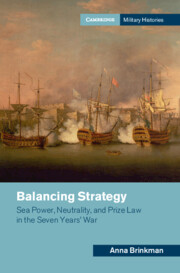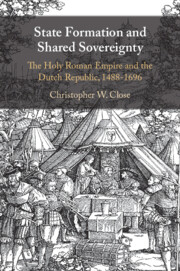34 results
5 - Quelling the Crisis
- from Part II - The Dutch Case Studies
-
- Book:
- Balancing Strategy
- Published online:
- 25 April 2024
- Print publication:
- 02 May 2024, pp 97-126
-
- Chapter
- Export citation
Conclusion
-
- Book:
- Balancing Strategy
- Published online:
- 25 April 2024
- Print publication:
- 02 May 2024, pp 245-268
-
- Chapter
- Export citation

Balancing Strategy
- Sea Power, Neutrality, and Prize Law in the Seven Years' War
-
- Published online:
- 25 April 2024
- Print publication:
- 02 May 2024
8 - Reformations in the Low Countries
-
-
- Book:
- Reformations Compared
- Published online:
- 14 March 2024
- Print publication:
- 21 March 2024, pp 167-189
-
- Chapter
- Export citation
2 - The World of the Bank
-
- Book:
- How a Ledger Became a Central Bank
- Published online:
- 16 November 2023
- Print publication:
- 30 November 2023, pp 17-52
-
- Chapter
- Export citation
13 - The Modernity of the Dutch Revolution: Ideas, Action, Permeation
- from Part II - Western, Central, and Eastern Europe
-
-
- Book:
- The Cambridge History of the Age of Atlantic Revolutions
- Published online:
- 18 October 2023
- Print publication:
- 09 November 2023, pp 349-374
-
- Chapter
- Export citation
9 - Politics and power, 1600–1789
- from Part II
-
- Book:
- Early Modern Europe, 1450–1789
- Published online:
- 30 August 2022
- Print publication:
- 25 August 2022, pp 335-382
-
- Chapter
- Export citation
4 - War
-
- Book:
- Reformation in the Low Countries, 1500-1620
- Published online:
- 02 June 2022
- Print publication:
- 09 June 2022, pp 105-140
-
- Chapter
- Export citation
5 - Schism
-
- Book:
- Reformation in the Low Countries, 1500-1620
- Published online:
- 02 June 2022
- Print publication:
- 09 June 2022, pp 141-181
-
- Chapter
- Export citation
7 - The Twin Faces of Calamity
-
- Book:
- Natural Disaster at the Closing of the Dutch Golden Age
- Published online:
- 13 January 2022
- Print publication:
- 27 January 2022, pp 251-276
-
- Chapter
- Export citation
1 - Rampjaar Reconsidered
-
- Book:
- Natural Disaster at the Closing of the Dutch Golden Age
- Published online:
- 13 January 2022
- Print publication:
- 27 January 2022, pp 26-50
-
- Chapter
- Export citation
4 - A Plague from the Sea
-
- Book:
- Natural Disaster at the Closing of the Dutch Golden Age
- Published online:
- 13 January 2022
- Print publication:
- 27 January 2022, pp 122-164
-
- Chapter
- Export citation
5 - “Increasingly Numerous and Higher Floods”
-
- Book:
- Natural Disaster at the Closing of the Dutch Golden Age
- Published online:
- 13 January 2022
- Print publication:
- 27 January 2022, pp 165-211
-
- Chapter
- Export citation
2 - “Disasters in the Year of Peace”
-
- Book:
- Natural Disaster at the Closing of the Dutch Golden Age
- Published online:
- 13 January 2022
- Print publication:
- 27 January 2022, pp 51-88
-
- Chapter
- Export citation
6 - “From a Love of Humanity and Comfort for the Fatherland”
-
- Book:
- Natural Disaster at the Closing of the Dutch Golden Age
- Published online:
- 13 January 2022
- Print publication:
- 27 January 2022, pp 212-250
-
- Chapter
- Export citation
3 - “The Fattened Land Turned to Salted Ground”
-
- Book:
- Natural Disaster at the Closing of the Dutch Golden Age
- Published online:
- 13 January 2022
- Print publication:
- 27 January 2022, pp 89-121
-
- Chapter
- Export citation
3 - Grotius and the East Indies
- from Part I - Grotius in Context
-
-
- Book:
- The Cambridge Companion to Hugo Grotius
- Published online:
- 03 September 2021
- Print publication:
- 16 September 2021, pp 65-88
-
- Chapter
- Export citation
2 - Grotius as Legal, Political and Diplomatic Official in the Dutch Republic
- from Part I - Grotius in Context
-
-
- Book:
- The Cambridge Companion to Hugo Grotius
- Published online:
- 03 September 2021
- Print publication:
- 16 September 2021, pp 45-64
-
- Chapter
- Export citation
Using one’s talents in honor of God: Lambert ten Kate (1674-1731) and Isaac Newton’s natural philosophy
-
- Journal:
- Science in Context / Volume 34 / Issue 1 / March 2021
- Published online by Cambridge University Press:
- 02 September 2022, pp. 25-50
- Print publication:
- March 2021
-
- Article
-
- You have access
- Open access
- HTML
- Export citation

State Formation and Shared Sovereignty
- The Holy Roman Empire and the Dutch Republic, 1488–1696
-
- Published online:
- 02 March 2021
- Print publication:
- 25 February 2021



